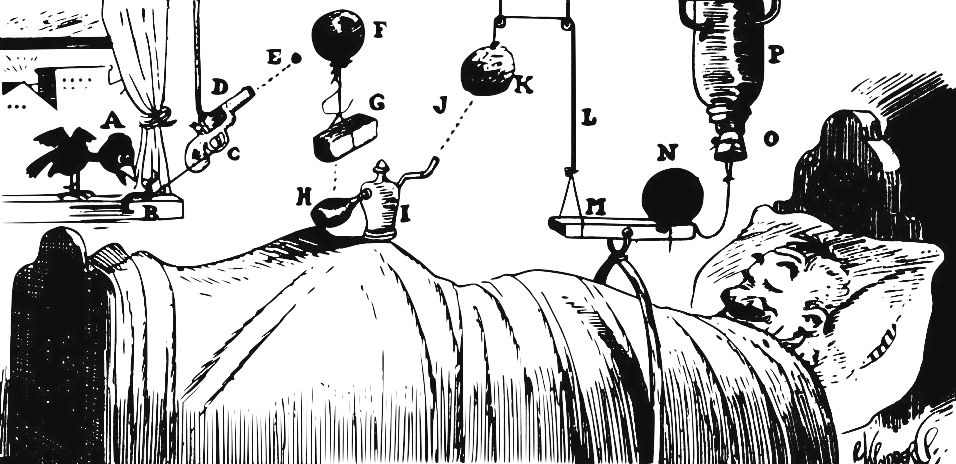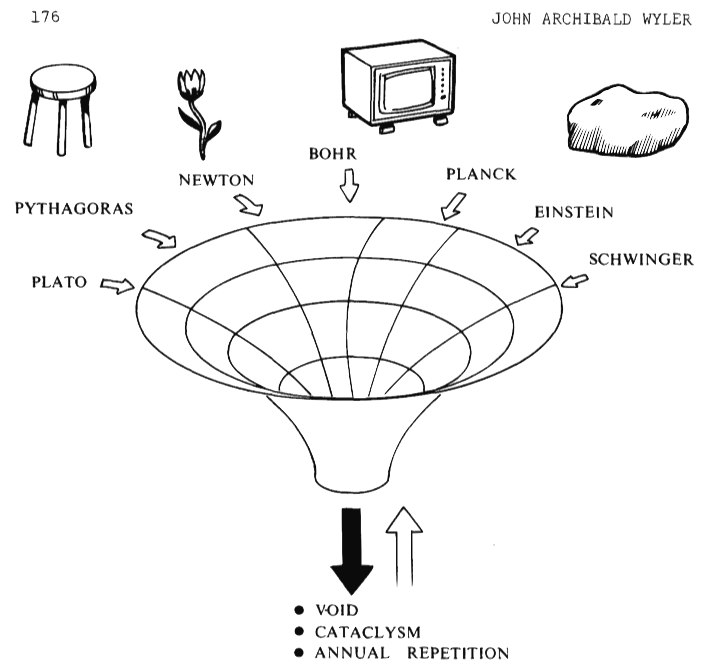Physics for People* Who Hate Physics
V. Gates, M. Roachcock, E. Kangaroo, and W.C. Gall
Multiversity Press, New York, New York, New York
*Of course, we mean the students, not the instructors.
Preface
The simple approach to physics is too dogmatic, & the people who advocate it are theorists, not real physicists, and should not be allowed to teach theory courses like this one. (Dogmatism is reserved for the accompanying lab course.) Beginning with a simple, general understanding is too formal: A real physicist works through all the examples, & then tries to understand it later; hindsight is more educational than foresight. It is only by repeating all the same mistakes that physicists made historically that one can learn history (although the student may need to repeat this physics course). This method was good enough for all physicists so far (except the formalists of the 1960's & 1970's), so it's good enough for the future. To follow history one must teach things the way they were first learned -- as a confusing mess. By this method physics can be shown to be as manly as any other subject, & its intrinsic simplicity & beauty can be buried at the end of each topic, by which time it will not be noticed.Unfortunately, most physics majors will avoid this course to take an honors course, where the subject is taught in the old, progressive way. That's fine, because there are more engineering students than physics students, so this textbook will make more money anyway. But unlike physics students, engineers will not stand for 2 full years of introductory physics. Thus a 2-yr. course must be crammed into a year. Since all physics topics are equally important (except the modern, formal ones), the same amount of material must be covered in half the time. This is another reason why the formal aspects must be reduced, & more emphasis placed on memorizing equations and plugging in numbers.
There is thus a clear need for a text directed toward people with no interest in the subject. The basic idea is to take people's interests in other topics and redirect them ("bait & switch"). This can be accomplished by making the subject matter resemble something more palatable ("tophusics"). The result is that the student will never get a deep understanding of physics, thus avoiding the need to destroy any deeply ingrained preconceptions.
Volume 1: Classical physics
Introduction: How to do physics on a 1970's calculator
 The basic idea is to eliminate algebra altogether. Emphasize the fact that physics is numbers, not letters. This is advantageous to both the student & the instructor because:
The basic idea is to eliminate algebra altogether. Emphasize the fact that physics is numbers, not letters. This is advantageous to both the student & the instructor because:
- The student needn't know (remember) how to use symbols.
- The instructor (who is assumed to know algebra) can assign problems, on both homework & exams, that are identical except for changes in numerical values.
Thus, the use of arithmetic calculators is mandatory. However, computers are not allowed, since modern machine programs can be taught to actually understand physics. Likewise, students are expected to memorize commonly used equations, which could be looked up in an electronic textbook or on the internet. There is a great deal of planned obsolescence in this model, but the only alternatives would be one of:
- Replace this course with one on the physics of dinosaurs, wormholes, and monster trucks.
- Eliminate the introductory physics course altogether.
- Teach actual physics.

Chapter I: Mechanics is machines
Two of the most fundamental ideas in physics are conservation laws and symmetries. For reasons explained in the Introduction, these concepts, and particularly their relation, must be avoided as much as possible, or at least delayed until after more traditional methods have been substituted. The easiest way to accomplish this is to introduce as early as possible less fundamental concepts that appear to violate some of these principles, such as friction, inelastic collisions, constant gravitational acceleration, etc.The essential teaching rule is to discuss as much as possible things that are already familiar to the students, to avoid the possibility of introducing totally new ideas. Pulleys, levers, ropes -- that's a real man's way to do physics. (Ah, for the good old days, when one didn't need a degree in computer science to fix a car.)
Eventually students will have to learn vectors, dot products, & even cross products. Delay each of these notions as long as possible, & don't let on that their existence has anything to do with rotational symmetry.
Chapter II: Gravity is missiles

What are the fundamental forces of nature? Magnetism? Friction? Love? Such a question is only good for understanding nature, not for getting a job, so stay away from it. So far, not too many people have gone into orbit, so stick to flat Earth gravity for as much of the course as possible. Copernicus is too advanced for this course.
Then what else is gravity good for? Hitting things! If it can't even make orbit, then a projectile must come down somewhere. So make sure something else is there to feel it when it does.
Chapter III: Hydrodynamics is plumbing
Statistical mechanics is the basic tool by which all macroscopic, composite objects are understood. It has no place in an introductory physics class. It is replaced by phenomenological laws of thermodynamics and the like. As we know from chemistry, moles are more important then molecules. And according to our dietician, calories are at least as important as joules. (Don't start me on those "erg" people.)Essentially, the instructor must avoid the physics of the little and concentrate on the physics of the BIG. Everything must be super-sized: meters & not centimeters, kilograms & not grams, Cal & not cal, etc. Bigger is better. But not too big. (See "Copernicus" above.)
Chapter IV: Waves are trigonometry
 Since students don't know algebra, they can in no way appreciate complex numbers, much less any kind of calculus. But trigonometry can still be applied as long as every sin & cos has a numerical argument. Just make sure to spend half the course using Babylonian units before converting to radians, lest the students get too comfortable with the concept of natural units. And stick to 1 dimension; you wouldn't want to let on that wave number is actually a vector.
Since students don't know algebra, they can in no way appreciate complex numbers, much less any kind of calculus. But trigonometry can still be applied as long as every sin & cos has a numerical argument. Just make sure to spend half the course using Babylonian units before converting to radians, lest the students get too comfortable with the concept of natural units. And stick to 1 dimension; you wouldn't want to let on that wave number is actually a vector.
Of course, start with macroscopic waves, like sound, water, ropes, etc. (See "Hydrodynamics is plumbing" above.) Then you can avoid any explanation of where waves come from, and why they are so fundamental. This strengthens the analogy with springs and their oscillatory motion, since we never explained where the spring force law comes from either.
Chapter V: Electromagnetism is wiring
Electric circuits should be taught before the dynamics of electrons. (See the discussion of macroscopic vs. microscopic under "Hydrodynamics is plumbing" above.) Thus wires must be taught before point particles. And whatever you do, give Maxwell's equations in 3-vector notation. We don't want students to get the idea that light might be relativistic. (Hey, Maxwell had no clue, & he was a lot smarter than you are.) Better yet, write the full equations only in integral form, where relativity is impossible to see, and in differential form write only the 1D wave equation. That way you can avoid talking about gradients, divergences, curls, & Laplacians. Not that you won't use them, you just won't talk about them (like the way you treat calculus in general).
 In particular, never even mention the d'Alembertian. Forget the fact that the discovery of this operator in 1747 was the first appearance of the wave equation, and thus the foundation of electromagnetism, special relativity, & quantum mechanics. Why do today what you can put off till tomorrow?
In particular, never even mention the d'Alembertian. Forget the fact that the discovery of this operator in 1747 was the first appearance of the wave equation, and thus the foundation of electromagnetism, special relativity, & quantum mechanics. Why do today what you can put off till tomorrow?
Volume 1.5: Modern physics
The first volume was modeled very closely after our favorite textbooks of the 1950's (which were themselves rewrites of textbooks of the 1890's). Although they are still wonderful texts for learning the topics of the 19th century, it is now the 21st century, & thus the ideal time for a new text introducing students to the results of the 1920's (with a brief discussion of the new ideas of the 1960's).These topics do not apply to familiar, everyday circumstances (global positioning satellites notwithstanding, since they are out of sight). Hence, unlike the previous topics, they must be made to appear more different, rather than less: The only way to justify their newness is to make them look so weird that they can safely be categorized as too bizarre to be comfortable with.
Chapter VI: Relativity is trains
Make sure to use square roots when defining Lorentz transformations, just to make them look as different as possible from rotations. (On the other hand, don't write rotations with square roots.) The important thing is to do things is a coordinate dependent way, not letting on that one can understand things by coordinate independent concepts. This is the way Einstein first invented it, & first is always best. The more abstract 1910 way of describing it is way too modern. Force them to consider coordinate transformations, rather than understanding the simplicity of choosing coordinates in a covariant approach. And don't dare to use units c=1. (Miles/second are OK, though. Those stupid British don't even use their own units anymore.)
 As Doctor Who once said, "Just as time is regarded as the fourth dimension, so space is equally the fifth dimension." If he didn't understand Minkowski space, then why should a college student?
That will allow you to skip any discussion of proper time as an invariant, used in defining energy-momentum as a 4-vector whose invariant length is the rest mass, etc. Thus you can also skip the relativistic definition of force, which could be used to understand the Lorentz force law. That would require a relativistic understanding of electromagnetism. There is only time to discuss relativity as it applies to free particles, not interacting ones, or even free waves. Thus you can limit any discussion of relativity to this chapter.
As Doctor Who once said, "Just as time is regarded as the fourth dimension, so space is equally the fifth dimension." If he didn't understand Minkowski space, then why should a college student?
That will allow you to skip any discussion of proper time as an invariant, used in defining energy-momentum as a 4-vector whose invariant length is the rest mass, etc. Thus you can also skip the relativistic definition of force, which could be used to understand the Lorentz force law. That would require a relativistic understanding of electromagnetism. There is only time to discuss relativity as it applies to free particles, not interacting ones, or even free waves. Thus you can limit any discussion of relativity to this chapter.
And make sure not to mention the Minkowski metric, because the analogy to the Pythagorean theorem might confuse them, since it looks so similar. They would then have a hint at general relativity, which is too advanced, and can better be explained by cartoons of the Earth sitting at the bottom of a rubber gravitational well. General relativity is geometry, and geometry is math, not physics.
Chapter VII: Quantum mechanics is nonrelativistic
Start with h, so you can use lots of 2π's, & hide ħ away for later. Forget what you just learned about the relation of energy to momentum, since it would make obvious that if one is related to wavelength the other is automatically related to frequency. Start with the 1D wave equation; leave 3D for when you finally get to the nonrelativistic hydrogen atom -- no point in giving them the full answer till the last moment. (See "Maxwell's equations" above.)Whatever you do, don't discuss the Klein-Gordon equation; it looks too similar to electromagnetism. After all, since particles & waves are really the same, nonrelativistic vs. relativistic is the only way we have to distinguish electrons & photons. Don't give a hint of spin (except semiclassically in atoms), despite the fact that we already described electromagnetic fields with vectors.
Appendices
The text is designed for students with any level of mathematical background whatsoever. The applications are designed to be implemented by rote, with knowledge of actual mathematics as superficial as that of the physics. In practice the student will have no aptitude for mathematics (for reasons similar to their lack of affinity for physics). However, we have added mathematical appendices, arranged in decreasing level of mathematical education, each directed toward a different field of interest. This allows the instructor to customize the course according to the student's major.- Mathematics for Engineers
- Mathematics for Medicine
- Mathematics for Poets
- Mathematics for Jocks
